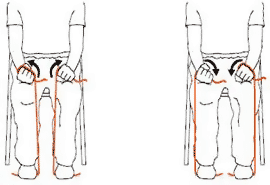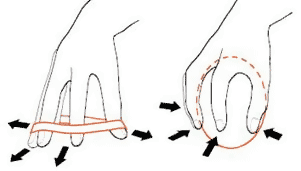
Tennis Elbow and Golfers Elbow
Tendon problems about the elbow are very common. They occur most commonly on the outside of the elbow, but may occur on the inside, and occasionally even on the back of the elbow. When tendon problems occur on the outside of the elbow it’s called “Tennis Elbow. When tendon problems occur on the inside of the elbow it’s called “Golfers Elbow”. These conditions are really the same thing, just in different areas. While the tendon damage of Tennis Elbow and Golfers Elbow can be due to an injury, they are more commonly due to tendon over-use which, over time, causes tendon breakdown. This tendon damage is called ‘tendinosis’, which means tendon degeneration. We used to call it ‘tendinitis’, which means tendon inflammation, but we now know that this is not correct. The pain of Tennis Elbow and Golfers Elbow comes from tendon breakdown and degeneration, not from inflammation.
Any activity that stresses these tendons, including tennis, golf, sports, manual labor, heavy lifting, or repetitive motions can lead to Tennis Elbow or Golfers Elbow. Despite its name, over 95% of “Tennis Elbows” do not occur in tennis players. Musicians, carpenters, assembly line workers, athletes, and many others who subject themselves to repetitive stresses are the ones most likely to develop Tennis Elbow and Golfers Elbow.
Treatment
Even though the involved tendons are located around the elbow, they are attached to the muscles that move the wrist and forearm. Therefore, it is overuse of the wrist and forearm muscles, not the elbow muscles, that leads to Tennis Elbow and Golfers Elbow. There is a balance between the stresses applied to an arm and the strength of the small arm muscles to handle these stresses. As long as muscle strength is equal to or greater than the applied stresses, the tendons are fine. But once the applied stresses become too high or too frequent, pain and injury can occur. If tendon damage occurs at a rate that is too rapid for the body to heal, tendon degeneration occurs. Therefore, to get rid of the pain and avoid future injury there are two options: 1) Improve the strength of the involved tendons, or 2) Reduce the stresses placed on these tendons.
Maybe the painful activity isn’t that important and could be avoided. Or stresses may be decreased when performing that activity. For sports, proper technique is very important in minimizing the stresses placed on the arm. The force used to swing a tennis racket or golf club, or to throw a ball should be generated by the large muscles of the legs and trunk. The shoulder and elbow are only supposed to transfer these forces to the ball, club or racket. If one tries to generate significant force from the shoulder or elbow, then this incorrect form predisposes to overuse injuries. Simply improving the sport-specific mechanics can greatly reduce the amount of stress that the tendons are subjected to, reducing the chance of injury or speeding up recovery. At work, utilizing proper mechanics and avoiding painful activities can be helpful.
“Counterforce bracing” can also be effective in reducing the stress experienced by the tendons about the elbow. Counterforce bracing reduces the tendon’s load by absorbing some of the stress before it gets to the tendon.
Limiting activities, proper technique, proper equipment, and counterforce bracing will decrease the stress load on the tendons about the elbow. However, the most important treatment is to strengthen the involved tendons, specifically the wrist extensors, wrist flexors and the forearm rotators. I prefer to use an elastic resistance, such as an isotube, for strengthening rather than a dumbbell weight, as elastic resistance has a lower risk of creating ‘flare-ups’, i.e. worsening the pain.
Please note that for the first four exercises involving wrist and forearm motion, the forearm is supported on the thigh and the elbow is bent. The other end of the isotube is secured by stepping on it with the foot. Alternatively, he forearm could be supported on a desk or the arm of a chair.
Exercises should not cause pain. Pain means that the tendons may be getting injured more. If pain occurs during strengthening, then either too much resistance is being used or the exercises are being performed too many times. The idea is to strengthen the weakened muscles, not to over-stress them. A counterforce brace should be worn while exercising to further reduce stresses on the tendons while strengthening them. To start, I recommend only one set of 10-12 repetitions per day for each exercise.
Steroid injections provide temporary pain relief in approximately 50% of cases. Unfortunately, steroid injections do not provide a permanent cure and wear off at an average of 3 months. However, if pain is limiting the performance of strengthening exercises, an injection may decrease pain enough to allow the exercises to be performed better. And it’s always nice to have less pain, even if it’s just temporary. If the injection site hurts afterwards, put ice on it.
Steroid injections should be placed deep to the tendons. Injections placed inside the tendons should be avoided, as this can create further tendon damage. Injections that are not placed deep enough may dissolve the fat just below the skin, leaving a permanent dimple, thinner skin and less padding over the tender bone and tendons.
The repeated use of cortisone injections is inappropriate. There is no advantage, and considerable disadvantage, in having more than one steroid injection. Repetitive injections may weaken the surrounding normal tissues, potentially leading to further damage and making the tennis elbow more difficult to treat.
Strengthening exercises, combined with appropriate bracing, successfully treats 75-95% of cases of Tennis Elbow or Golfers Elbow. The others continue to have pain that limits their activities. This occurs because the amount of tissue damage is too great for their body to repair. People in this situation have a choice: accept the condition and limit activities accordingly, or have the problem treated surgically.
Surgery
When non-operative treatment fails to provide relief from Tennis Elbow or Golfers Elbow, there are simple surgical solutions that are approximately 97% effective. Both involve a small incision, only about 2″ long, through which the damaged, abnormal, unhealthy tendon is removed.
Tennis Elbow Video
Golfers Elbow Video:
However, many older surgeries are still performed. Many of these try to repair the tendon or remove bone. Not only do these not work well, but they cause additional pain, and can lead to permanent elbow stiffness and weakness. Releases may damage the elbow’s Lateral Collateral Ligament, which is located directly beneath the tendons; this can lead to further pain and elbow instability. Please see the “Elbow Ligament Injury” section of this website for more information. Many older operations leave the damaged, degenerated and painful tendons behind. And once an unsuccessful surgery has been performed, the chances that an appropriate surgery can fully treat Tennis Elbow or Golfers Elbow decreases to about 84%.
Following surgery, the elbow is splinted for 3 days, during which time it must be kept clean and dry. Bathing is safer than showering. Wrap a towel around the dressing in case any water gets in, then place a plastic bag over the dressing and secure it tightly with rubber bands. If a bathtub is not available, Walgreens makes the best cast covering.
After 3 days the splint and dressings can be removed, the incision can get wet in the shower, and elbow motion should be regained. A hot shower is a great time to work on elbow motion: fully straightening the elbow, fully bending it, and rotating the forearm from palm up to palm down. After showering, blot the wound dry.
For Tennis Elbow surgery, the stitches are absorbable: There are no stitches to remove. There is a piece of special tape over the wound. The longer it stays, the nicer the wound will do. It’ll fall off when it’s ready. Don’t get the wound dirty or submerge the incision under water for 10 days after surgery.
For Golfers Elbow surgery, regular stitches are required. After blotting the wound dry, bend the elbow and place a large band-aid or light dressing over the wound. Don’t get the wound dirty or submerge the incision under water until the stitches are removed, usually at the first post-operative visit, 2 weeks after the surgery.
So the take home message is this: Tennis Elbow and Golfers Elbow are relatively common, but the chance of getting them can be decreased by using proper techniques, both during athletics and at work. The vast majority of Tennis Elbow and Golfers Elbow can be treated with activity limitation, a counterforce brace and a specific strengthening program. And for those patients who do come to surgery, modern techniques of Tennis Elbow and Golfers Elbow Excision have an excellent rate of success.
Tennis Elbow Therapy Protocol
Exercises:
1) Wrist extension
2) Wrist flexion
3) Pronation
4) Supination
5) Finger extension
6) Ball squeeze
I greatly prefer elastic resistance to weights. Start with low resistance. Perform 10-15 repetitions of each exercise. Only 1-2 exercise sessions per day; more is not necessarily better, and can exacerbate symptoms. Each repetition is held for 2 seconds. The elbow should be bent 90° and the forearm supported on your thigh or a table.
Counterforce brace should be worn. Do not work through pain. Soreness for 1-2 hours after exercising is OK, but sharp pain, or soreness the day after means that less resistance should be used, or the number of repetitions decreased.






